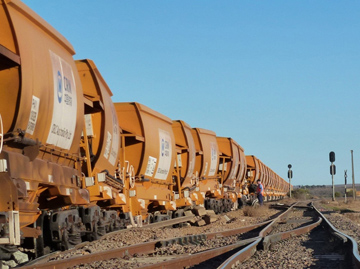
On 17 February 2013, ore train 9614S was departing Spencer Junction en route to Whyalla, South Australia. While the train was traversing 38A points at the northern end of Spencer Junction, the driver noticed a change in the train’s dynamic behaviour and immediately reduced the throttle.
The train then quickly came to a stop due to the automatic application of the electronically controlled pneumatic train brake. Upon inspection of the train, the second driver discovered five ore wagons were derailed.
The ARTC’s inspection and maintenance practices were ineffective at identifying and correcting the deteriorating condition of track infrastructure exhibiting accelerated wear, such as 38A points at Spencer Junction.
The ATSB’s investigation found that the leading edge of the right hand 38A point blade was worn and damaged. The blade damage had created a ramping angle, allowing the lead wheel of the ore wagon to “ride up” the blade and derail. The derailed wheels then impacted and damaged the concrete sleepers, which ultimately failed to maintain track gauge and allowed further wagons to derail. During the derailment sequence, a rupture to the train’s electronic control pneumatic pipe initiated the application of the train brake.
The ATSB found that the Australian Rail Track Corporation’s inspection and maintenance regime, following two similar derailments at the same location, had not been sufficient to identify and remediate the deteriorating condition of the 38A points, and ultimately contributed to the derailment.
In the months leading up to this derailment, Genesee Wyoming Australia (GWA) and the Australian Rail Track Corporation (ARTC) had agreed to a rail upgrade programme which included a new turnout incorporating 38A points, using 60 kg rail laid on concrete bearers. At the time of this derailment, a new turnout had been prepared, but had not yet been installed. Upgrade works have since been completed.
Following installation of the upgraded infrastructure, more frequent monitoring for wear rates of the point blade(s) was undertaken. After several months of condition monitoring it became evident that track performance and wear rates could be managed as specified in the Code of Practice and the normal inspection schedule was reinstated.
Safety message
Track infrastructure owners and maintainers should consider the associated increase in wear on track infrastructure when there is an increase in the volume of rail vehicles being operated. The high dynamic forces that may be exerted from rail vehicles, specifically those that bear a heavy axle load, will accelerate the rate of wear on track infrastructure.
In these circumstances, increased inspection and maintenance of track components should be considered until it can be established that resulting wear rates can be adequately managed in accordance with the established standards.
Read the final report: Derailment of train 9614S, near Port Augusta, South Australia, on 17 February 2013


